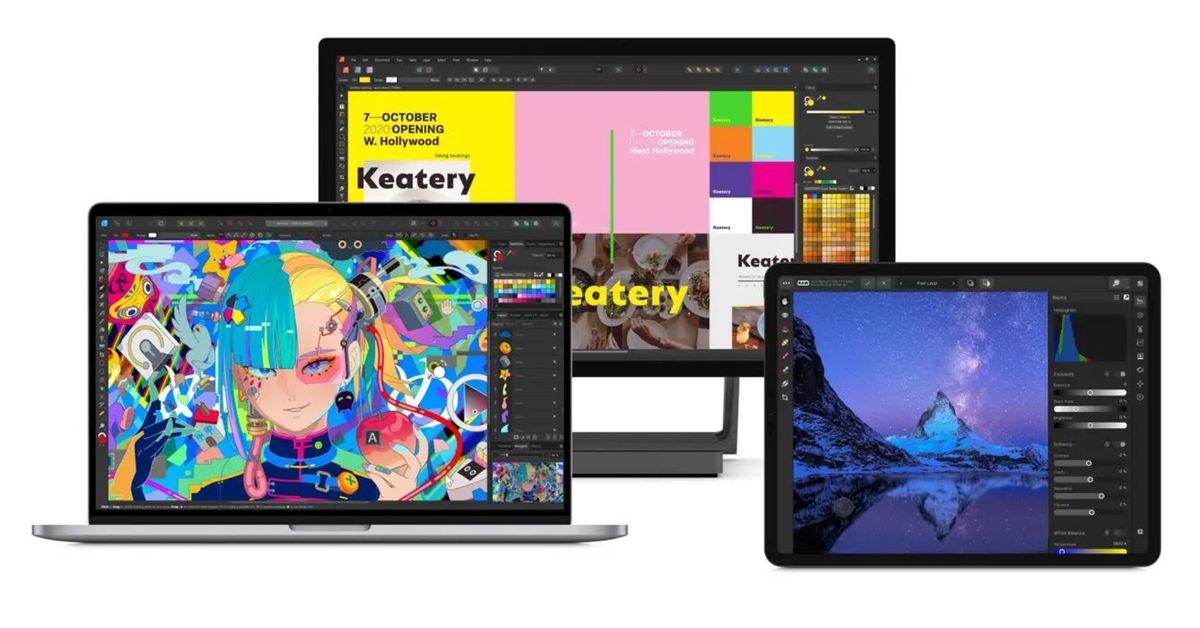I dumped my Adobe sub and grabbed Affinity Photo a while ago. It does 95% of the things Photoshop does (and 100% of what I need) for a one-time payment that is a fraction of the cost of an Adobe payment. It’s runs so so SO much better than PS. I very often saw Photoshop using up to 40gb of RAM and Affinity Photo uses 9gb doing the exact same work with the same files.
Removing Creative Cloud and it’s 838 different processes was amazing. Like finally watching your toilet flush after it’s been clogged.
I’ve only used the v1 affinity suite, so I can’t speak for the latest versions of v2, but when I started the first thing I noticed was the performance. It’s much more responsive.
Photoshop using up to 40gb of RAM and Affinity Photo uses 9gb
Not using all of the available RAM is not a good thing…
E: my PC doesn’t have anywhere near 40GB of RAM and yet still runs Photoshop just fine. Why do you think that is? 🤔
This is only remotely true if you have a box dedicated to doing one single thing and nothing else. That is almost certainly not the case for the vast majority of Photoshop users
This is not remotely true.
Consumer software running on a consumer OS should not be grabbing all available RAM just because. Doing so will cause other applications to be moved to swap and have to be loaded back into RAM when the user goes to use them. In a server environment doing something like running a SQL server it would make more sense to grab all available RAM and start aggressively caching frequently accessed data in RAM to present it sooner with the assumption that the server’s primary role is to perform SQL operations as quickly as possible.
Specifically with Photoshop what would be the benefit of it be aggressively reserving RAM beyond what is needed to function?
Doing so will cause other applications to be moved to swap and have to be loaded back into RAM when the user goes to use them.
This is non-sense. Any modern OS will allocate RAM as necessary. If another application needs, it will allocate some to it.
this is not true.
it entirely depends on the specific application.
there is no OS-level, standardized, dynamic allocation of RAM (definitely not on windows, i assume it’s the same for OSX).
this is because most programming languages handle RAM allocation within the individual program, so the OS can’t allocate RAM however it wants.
the OS could put processes to “sleep”, but that’s basically just the previously mentioned swap memory and leads to HD degradation and poor performance/hiccups, which is why it’s not used much…
so, no.
RAM is usually NOT dynamically allocated by the OS.
it CAN be dynamically allocated by individual programs, IF they are written in a way that supports dynamic allocation of RAM, which some languages do well, others not so much…
it’s certainly not universally true.
also, what you describe when saying:
Any modern OS will allocate RAM as necessary. If another application needs, it will allocate some to it.
…is literally swap. that’s exactly what the previous user said.
and swap is not the same as “allocating RAM when a program needs it”, instead it’s the OS going “oh shit! I’m out of RAM and need more NOW, or I’m going to crash! better be safe and steal some memory from disk!”
what happens is:
the OS runs out of RAM and needs more, so it marks a portion of the next best HD as swap-RAM and starts using that instead.
HDs are not built for this use case, so whichever processes use the swap space become slooooooow and responsiveness suffers greatly.
on top of that, memory of any kind is built for a certain amount of read/write operations. this is also considered the “lifespan” of a memory component.
RAM is built for a LOT of (very fast) R/W operations.
hard drives are NOT built for that.
RAM has at least an order of magnitude more R/W ops going on than a hard drive, so when a computer uses swap excessively, instead of as very last resort as intended, it leads to a vastly shortened lifespan of the disk.
for an example of a VERY stupid, VERY poor implementation of this behavior, look up the apple M1’s rapid SSD degradation.
short summary:
apple only put 8GB of RAM into the first gen M1’s, which made the OS use swap memory almost continuously, which wore out the hard drive MUCH faster than expected.
…and since the HD is soldered onto the Mainboard, that completely bricks the device in about half a year/year, depending on usage.
TL;DR: you’re categorically and objectively wrong about this. sorry :/
hope you found this explanation helpful tho!
for whom? as a power user, I’d keep affinity photo or photoshop, maya, max, blender and godot/unity open at the same time. I DO NOT WANT PS EATING UP ALL THE RESOURCES. Affinity so far (only 4 months into it) has been a delight.
for whom?
For everyone?
I’d keep affinity photo or photoshop, maya, max, blender and godot/unity open at the same time.
And any modern OS will allocate the necessary amount of memory to each task.
You speak from the perspective of someone who’s either always had enough RAM, or not enough work to do.
I speak as someone who has used a computer before and paid attention to dynamic memory allocation.
I’m going to assume sarcasm, no?
No, of course not. Why have all that RAM and not use any of it? This is a very common misunderstanding.
This is true but only to a point. I have 64GB of RAM and I have seen Photoshop overshoot that and start eating up 20gb of page file. Working with the exact same files in Affinity Photo - it uses a quarter of that.
There is a difference between “Efficiently use available memory for program functions” and “Fill all available memory with bloat and poorly coded rubbish”
If your software’s function can be replicated using only 1/4 of system memory then your software is poorly written. Which Photoshop is.
The benefit of having unused RAM is that every program you are using can remain in memory for quick multitasking access and when you go to launch a new program it can be loaded into that unused RAM without unloading any of the currently running programs. What part about that is a misunderstanding? Would the user be better off if the application in focus aggressively reserved RAM it didn’t need to slow down every other running application? Because that’s what Photoshop does
What part about that is a misunderstanding?
The part where you assumed 20GB is 100% of OP’s RAM, leaving nothing for any other programs.
we all need a little swap here and there, right
Not using available ram only is true when doing so could offer performance benefits. Many applications can’t be sped up by using more ram. Using more ram for no obvious reason is stupid, especially on a machine that has to do other things at the same time.
I mean what differences does it make if it’s needed or not if it’s not in use?
Bad memory management can actually slow down applications significantly. Allocating memory is actually a fairly expensive operation. So much that high performance software actually uses a bunch of tricks to avoid extra allocations where possible. Additionally, accessing memory is actually kinda slow for a CPU, and the CPU often has to sit around for many clock cycles waiting for memory to be retrieved if it’s not in the CPU’s cache. If your main data can be stored more compactly, more of that data can fit in your CPU’s cache, reducing that idle time.
Bad memory management can actually slow down applications
Who said anything about “bad” memory management?
Bad memory management includes allocating memory you aren’t actually making use of.
How is that bad?
The Canva ownership still worries me.
Yep, I’m still suspicious we’re in the good phase before things get anti-consumer
Absolutely - me,too.
But, to play the optimist for once - Canva could bring some good to Affinity/Serif. Canva is available as a native linux app and Serif in the past has stated multiple times it’s mainly the lack of Linux resources and experience that stops them from providing Linux support. So maybe that could be a good influence.
Canva also has a workflow that is based on a webapp that is more “beginner friendly” than Affinity and a good integration between these services could be a good thing as it may remove barriers.
And Canva for a long time had a desire to provide a full production workflow, so maybe affinity gets the long missing library features.
BUT: Now enough with that optimism, sadly I am rather sure enshitification is around the corner. Which will be a sad day for me.
Me too… but its still good till it goes to snit.
I would buy Affinity Photo if they had a Linux version. Sure, it could be run in Wine, but I don’t like using it for anything except games.
It doesn’t even really run on wine from my experience
I saw a lengthy guide once on how to run it but it wasn’t simple. Still better than Photoshop though
True, I rather use Photopea than trying to make it work under wine
Those who actually use it, can they write down a simple comparison?
I did not use Photoshop particularly long, but I have been using the Affinity Suite both on a pc and a tablet for over a year now and can say it’s definitely quite good. Everything is where you think it should be, the workflow feels very usable with no major learning curve (looking at you, GIMP), and overall the only thing I don’t like about it is its lack of Linux support. I would assume that absolute professionals won’t be able to find everything they like/want, but if you’re reading this, chances are you’re gonna be more than satisfied, if FOSS options don’t quite work for you.
I use the suite professionally. I come from the Corel world (which I slowly got to hate, but sunken cost, etc.) which I have gladly escaped. The suite is just a bonkers value. I live in Linux, but have a windows virtual machine just for Affinity.
Check this video as well. I do share most of that experience of having to Google how to do some things because it’s not immediately obvious, and some other things do take more clicks/effort than they should’ve compared to Photoshop. All in all, it has completely replaced Photoshop for my use case.
I have been using Affinity Photo for a couple of years now. Not in a professional way, just for some small personal things. Before buying Affinity Photo I used PS for the same purposes for a few years.
I don’t see me going back to PS, since Affinity has everything I need. Sadly, I don’t remember specifics, but a few things work a bit different in Affinity, but the workflow is quite similar.
Note that I am not using the latest version, so things might have changed.
It’s a very good app suite that gets the UX right esp if you use multiple of their apps but it falls short in areas that Adobe has had more r&d money thrown at, such as vector tracing, proper vector brushes, and proper psd support (you can import psd files, you cannot export fully editable psd files). I used it myself for branding and UI design for a few years and it’s definitely worth the money, but they do have some issues as I’ve said before. Their file format isn’t open source either afaik and there is no plugin support so it’s a friendlier looking and cheaper closed ecosystem.
What is the open alternative?
There sadly isn’t a viable one at the same level of functionality.
Edit: some random other comment appeared here. Fixed.
Depends with what you might want to achieve, some people will say inkscape or gimp. In my minimal experience while they win in some departments like plugins and features their UX and UI is really not as good, but that’s just how it worked for me, some people would swear by them.
That I noticed, I can only save in their format, not that good
Those who actually use it, can they write down a simple comparison?
Those AI features are completely absent from Affinity. That said, Serif was recently bought by Canva who have AI features in their web suite, so I expect those to come to Affinity at some point, possibly requiring a subscription for cloud-enabled features (regular Affinity feature set will remain pay-once and offline, according to announcements). I hope some AI-supported upscaler will come to Affinity. I currently use some free web tool for nicer upscaling.
Also, Affinity apps don’t support file format plugins at all. AVIF and HEIF aren’t supported, so you’ll need external converters to open those.
deleted by creator
I checked it out last night. The photo editor is close enough to photoshop that I’ll be glad to buy it. From my preliminary perusing of the tools and features, the only thing I used in photoshop that isn’t in affinity photo was the ability to animate things. I’m sure there are some other more important details between the two, but as a hobbyist for graphic design it fits my needs just fine.
The issue is that they recently were sold to canva. An online, subscription service that offersjtemplate based graphics suite.
Affinity promised that they would not change their model to subscription but many users doubt their credibility after the sale to canva
If they had library management even close to what lightroom offers, I’d be there.
I may yet jump ship for photoshop.
I think it’s only a good thing they’re not trying to shoehorn DAM features into their existing apps. If they made a DAM software it’d have to be an external app anyway.
I did perfectly fine with digiKam in the past, and nowadays I’m perfectly happy with ACDSee. ACDSee even shows thumbnails for Affinity Photo project files.
DAM DAM?
ACDSee even shows thumbnails for Affinity Photo project files
You’re telling me there’s an image managing program out there, that works with Affinity, and for some reason people aren’t talking about it???
DAM as in digital asset management. Fancy word for “image library organiser”.
Oh, everything works with Affinity. Thing is, Adobe is pretty much the only software ecosystem that is subtly (or not so subtly) making people think inwards. “I’d love to try that piece of software, but if it’s not running as a Photoshop/Lightroom plug in, is it even worth trying?” Whereas when people who use other software are more likely to go “Well my favourite software package doesn’t do thing X, but I have this other piece of software that does that, it’s not even a hassle.”
Also, when I switched from digiKam to ACDSee, at no point did I have to go “but what about my Adobe-locked-in catalogue, oh no!”…
100% my Lightroom libraries are a non-starter when it comes to still needing Adobe. Literally hundreds of thousands of photos from this year alone are cataloged there, and I’m not sure any of the FOSS alternatives can manage that
That’s a completely different application. You could try darktable, its free and open source and really good imo. A bit more complicated than lightroom for editing, but also more powerful (apart from ai features, which it lacks)
And then what?
Then you can get permanent access for 165 USD (one-off payment)
It goes on sale often. I think I got it for $50 a while back.
Easily worth it. Supporting a customer friendly business model is how we keep nice things.
Only gripe is missing aftereffect alternative. Some kind of AI-AE workflow would have made me jump ship immediately. Don’t care much for photoshop
Hmm. Think I would rather pirate Adobe.
It’s currently $137.99 AUD for me.
They lost all credibility when they sold out to Canva in my opinion.
I didn’t know that but yep, I feel the same way. I have absolutely nothing good to say about Canva after having to work with a bunch of people who sent me files from it.
As a teacher, I use publisher all the time to make prints and materials for lessons. I’m still learning new tricks with it. And having Affinity Photo integrated means I click a tab and can better toy with images without having to swap the application.
This is the best summary I could come up with:
Design software developer Serif has launched a new six-month free trial for its Affinity creative suite, which is well regarded as being one of the few viable alternatives to Adobe’s professional design apps.
Affinity uses a one-time purchase pricing model that has earned it a loyal fanbase among creatives who are sick of paying for recurring subscriptions.
Prices start at $69.99 for Affinity’s individual desktop apps or $164.99 for the entire suite, with a separate deal currently offering customers 50 percent off all perpetual licenses.
This discount, alongside the six-month free trial, is potentially geared at soothing concerns that Affinity would change its pricing model after being acquired by Canva earlier this year.
“We’re saying ‘try everything and pay nothing’ because we understand making a change can be a big step, particularly for busy professionals,” said Affinity CEO Ashley Hewson.
In a Decoder interview published today, Canva CEO Melanie Perkins declined to describe its offering as a full alternative to Adobe’s Creative Cloud.
The original article contains 234 words, the summary contains 161 words. Saved 31%. I’m a bot and I’m open source!
Adobe should be forced to repay all cancellation fees they ever charged then fined the same amount again unless it’s under 25% net yearly income in which case they are fined 25% for each year they were defrauding customers
love affinity but, god, i just want a procreate for my galaxy tab



















